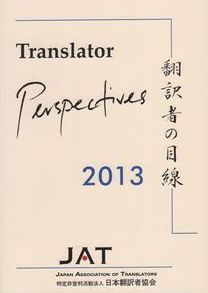April 7, 2014
A Delectable Assortment: Translators Showcase Advice, Writing Skills
By Rachael Ragalye
Translator Perspectives (Hon’yakusha no mesen). Tokyo: Japan Association of Translators, 2013. 97 pages. ISBN 978-4-906408-09-2.
 Of all the things I expected to see in a volume titled Translator Perspectives, advice about what makes for a good udon noodle shop was not one of them. In his essay Oishii kake-udon o mezashite, Kunieda Shirō tells us that the true test of a good udon shop is its kake-udon. This seemingly simple dish—just a bowl of udon noodles in broth, garnished with a handful of chopped onions—is actually a test of skill for the cook. There are no fancy toppings like deep-fried shrimp to distract the diner from the quality of the meal’s two critical basic ingredients: the noodles and the broth. If the shop cannot produce a satisfying meal with those alone, then it’s all but certain that anything else they prepare will also leave something to be desired.
Of all the things I expected to see in a volume titled Translator Perspectives, advice about what makes for a good udon noodle shop was not one of them. In his essay Oishii kake-udon o mezashite, Kunieda Shirō tells us that the true test of a good udon shop is its kake-udon. This seemingly simple dish—just a bowl of udon noodles in broth, garnished with a handful of chopped onions—is actually a test of skill for the cook. There are no fancy toppings like deep-fried shrimp to distract the diner from the quality of the meal’s two critical basic ingredients: the noodles and the broth. If the shop cannot produce a satisfying meal with those alone, then it’s all but certain that anything else they prepare will also leave something to be desired.
Yes, but what does this have to do with translation? Translators, Kunieda explains, should produce work that is like kake-udon: solid in quality at the most basic level.
Kunieda’s essay itself exemplifies solid quality in writing, the skill Carol Lawson claims that all good translators must have. In Should I Become a Translator? How Can I Be Sure I Will Succeed?, she observes that the best translators are those who are outstanding writers in their native language. Further, her assertion seems to be supported by all of the brief pieces included in Translator Perspectives. The quality of the translators’ writing makes this anthology a great read even for those not directly associated with the field of translation.
Sixty-seven contributors, including native speakers of English and Japanese, have condensed years of experience into a 1,000 or so words each to create this informative and entertaining collection. Submissions include advice by way of both anecdotes and concrete suggestions, stories of success and failure, introductions to new software, assessments of the state of the translation business, and reflections on what makes translation such a compelling profession. Thanks to these translators’ skill at writing, Translator Perspectives offers substantial benefit to those of us who work in any capacity with Japanese users of English.
As an assistant English teacher, I couldn’t help but sympathize with the challenges put forth in Grammar and the Client by Torkil Christensen. Many of us often find ourselves obliged to provide reasons for our usage choices to our clients (or students or coworkers) even though we may be unaware of the meta-reasons behind our intuitive knowledge of what makes something “right” or “wrong.” Christensen also notes the challenges of arguing for language that “sounds right,” especially when the usage in question goes against a client’s hard-learned grammatical rules.
In “Translators and the Editing Tightrope,” Dianne Kirk writes of a related issue as she reflects on the difficulties experienced when “editing,” “revising,” “proofreading,” or providing a “native check”—work that can run the gamut from weeding out awkward or dated expressions to a complete rewrite of the text. She also brings up an interesting question of language ownership as it relates to the process of editing, asking editors to consider whether their changes genuinely enhance the text or are simply to make it match their personal preferences. Teachers, writers, and undoubtedly many others often face situations in which they must confront similar questions.
The essays in Translator Perspectives reveal the authors’ passion not only for the profession itself, but also for professional development. Several authors reflect on how language changes with time and the consequent importance of ongoing education. Others discuss how software can help translators produce better results. All seek to impart advice on how to make the finished product even better, not for the translators’ sake, but to achieve the purposes of those they serve with their language abilities—much as cooks produce delicious udon not for their own satisfaction, but for the enjoyment of their diners.
Both helpful and amusing, Translator Perspectives is an anthology I highly recommend to anyone who works with Japanese and English. Bon appetit!
Rachael Ragalye is an assistant language teacher at Chuo Secondary School in Takasaki, Gunma Prefecture. She majored in anthropology and Asian studies at Mount Holyoke College and served as a speaking, arguing, and writing (SAW) mentor there during 2010–2012. Outside of work, she practices hip-hop dance and singing.
This article was written originally for the SWET website, March 19, 2014.
